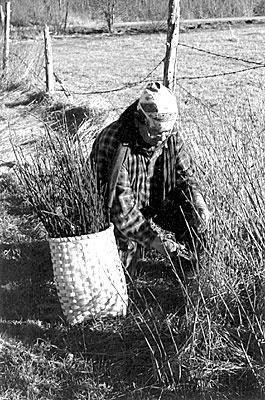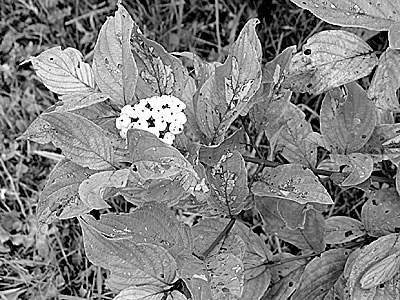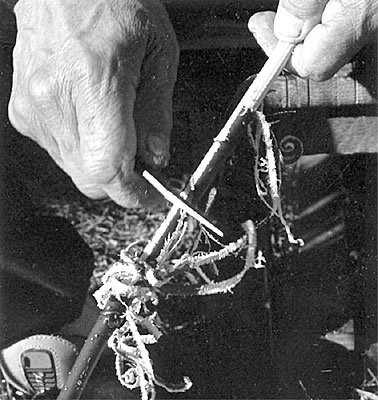 |
| Fredda Paul harvests red willow (Cornus stolonifera) in the spring. Leslie Wood photo. |
By Fredda Paul with Leslie Wood Paul
Fredda Paul, Passamaquoddy tribal member, practices Indian traditional medicine as first learned from his grandmother. He and Leslie work together harvesting, making medicine and helping people return to the old ways of healing. Contact them for a medicine list or information on workshops at (207) 853-4578 or [email protected].
Honoring Our Elders
Fredda
My grandmother first passed the knowledge of medicine to me. She spoke in her native language. Through her I learned to respect both the language and the plants.
The Passamaquoddy word Nespihqamq (pronounced “nes – bee – kwamqw”) means “to be used with other.” Most tribes in North American know the value of this plant; to each one it may be used in some way that our people may not know. Different tribes may know it in their own language. Each one will have something to add about the medicinal properties that our tribe doesn’t know. That is how I get all the information about medicinal plants. What they tell me I don’t know and what I tell them they don’t know. We share information.
Name Sharing
Leslie
Why “red willow” when this plant is really a dogwood? Known by the common name Red Osier dogwood, or the botanical name Cornus stolonifera, it shares many qualities associated with willows (Salix spp.). The plant stem is flexible and is often made into baskets and wreaths. Like willow, Red Osier dogwood has aspirin-like qualities and is used to clear the effects of radiation.
 |
| Red willow in fruit in August. Leslie Wood photo. |
Tribes throughout the continent may use different varieties of red willow, according to Charlotte Erichson-Brown in Medicinal and Other Uses of North American Plants. In Maine we find and harvest Cornus stolonifera, a shrub noted by its shiny red twigs that usually grow 3 to 5 feet tall and are striking in a winter landscape. The small white blossom grows in oval to round clusters approximately 2 inches in diameter, followed by a round cluster of pea-size white berries. Many varieties of red-twigged dogwoods exist, but not all are good medicine. Look for the deep red color on the entire woody part of the twigs, not just on the ends. When cut, Cornus stolonifera will have a white pith, while others have shades of brown, ranging in color from weak tea to coffee.
Sacred Tradition
“I will first make an offering and send a voice to the Spirit of the World, that it may help me to be true. See, I fill this sacred pipe with the bark of the red willow.”
– Black Elk, Lakota Sioux
Fredda
Red willow has played a big part in our traditions – when people needed to talk heart to heart, for elders meeting in counsel, in sacred ceremonies, or for its diverse medicinal properties. It is smoked to help the mind, body and spirit. We never use it just for pleasure.
For hundreds of years people were destroying our sacred medicine. Medicine was a source of power and strength; destroying it was a way to try to keep our people down. Our tribe has been very secretive about medicine for this reason. Very little useful information about red willow has been let out. I believe it is time now to share this information because it has a great capacity to help people.
Medicinal plants are still being destroyed because of logging and construction, even clearing a field. But we can change things. We can be on the alert to protect the plants.
Smoking Medicine
In Passamaquoddy, tomaway [tuh – mah´ – way] means “the thing you smoke.” It could mean red willow or any number of things that are smoked for medicine. Or it could mean the tobacco that most people know all too well.
Fredda
Smoking medicine puts the healing properties directly into the bloodstream. It’s not like smoking modern-day tobacco with nicotine and all the chemicals added. The smoke can actually cleanse the whole body as the medicine goes through the bloodstream. This can be more effective than drinking teas. When you drink tea, it heals only on the inside, not on the outside. Smoke comes in and lingers all through your body, gradually healing from the outside to inside.
Leslie
Many people have a hard time with this concept, especially those who are sensitive to smoke. We tell people who are allergic or have asthmatic tendencies to start very slowly, taking just one or two puffs at a time. The paradox of smoking medicine is that it can actually help heal problems associated with asthma and breathing difficulties.
“To Be Used with Other”
Red willow, or in Passamaquoddy, nespihqamq, is a medicine that works excellently for treating a wide range of conditions when used in combination. Maybe that is why it is very rare to find red willow being sold except in smoking mixtures.
Fredda
My grandmother smoked red willow in a homemade corncob pipe every morning and every evening. She would mix it with sage in the morning and with lobelia in the evening. Sage will mellow out red willow. Smoking the mixture will help the mind become alert. [“Sage” for most Native Americans is actually Artemisia, often called “wild sage.” The smoke from culinary sage (Salvia spp.) will give some people a headache; however, the smoke from Artemisia will cure a headache. For our purposes we harvest and use Artemisia ludoviciana (or ‘Silver King’) Plants are available from Richters Herbs in Ontario; www.Richters.com.] Lobelia works together with red willow to relax the mind and body for a good night’s sleep.
For headaches and migraines, we have more success using red willow with sage. But it must be used on a regular basis, not just when the person gets a headache. I usually suggest that the individual smoke a couple of puffs every two hours or one cigarette over the course of a day.
Both mullein and colt’s foot can be smoked to help heal the lungs and are excellent remedies for asthma and bronchitis. In both plants, you’ll find black spots in the fall. A lot of people think this is mold, but my elders taught that this is actually the beneficial oil coming out and the medicine is at its peak. Mullein or colt’s foot can be smoked individually or mixed with red willow at night to bring the medicine down deep into the lungs while the body is resting. Lobelia is also good for asthma and bronchitis.
Still Good Alone
Red willow has a very powerful effect alone. Most of the time a couple of puffs will relieve nausea or a headache, or help relax a person to get a good night’s sleep. It opens the liver and digestive organs and can settle a queasy stomach almost immediately. It has been used for people who get nausea and insomnia due to chemotherapy. It can jump-start a person to settle into a peaceful state of meditation and bring the mind into focus.
We tell people to try one or two puffs at first. Each individual is affected differently, and for some people, smoking red willow may be overstimulating. To get the most out of the smoke, breathe deeply into the belly, hold it, and exhale slowly.
For earaches, blow smoke of red willow bark in the ear, maybe a couple of times. This is safe even for young children. Using a straw will help get the smoke directly into the ear.
Eye Medicine
Fredda
Red willow is excellent medicine for the eyes. Even chewing on the dry bark can help. You can make a tea from the dried bark; or even better, make an oil from fresh bark and extra-virgin olive oil, straining carefully and refrigerating. Massage one drop into your eye or on your eyelid, morning and evening. This is especially good for children and people with sensitive eyes. It will work for animals, too. This works for pink eye, and can even be used to dissolve cataracts and reverse macular degeneration. It takes time, maybe up to three months or more. The person should not be on any prescription medication; even some Chinese herbs are too strong. The eyes are very sensitive, and you will have a major battleground on the eyeball once the red willow picks up the energy of a foreign substance.
How To
Fredda
My favorite way to smoke red willow is to roll a cigarette. It goes direct into the lungs without mixing with air, so it is less harsh. To keep it moist and easier to roll, you can store a small jar of red willow in the freezer.
Leslie
Sometimes we have a group of people pass around a shell of red willow bark and let everyone inhale through a straw. The smoke can also be inhaled directly from the shell. The gentlest way of all is to sit in a small room and smudge with red willow by putting a teaspoon of bark in a shell.
 |
| Fredda scrapes the bark from red willow, working from the large to small end of the stem. Leslie Wood photo. |
Harvesting
Fredda
Optimum times for gathering red willow are in the spring, the week before the leaves come out; or in the fall, the week after the leaves fall or as the leaves are dying. Cut high enough from the ground to get the reddest part of the stem. Keep the stems in a cool place and try to scrape the bark within 24 hours. Twigs that sit too long will be tough to scrape, and the quality of the medicine will go down.
Remove all small side branches, cutting close to the main stalk. Scrape all the way to the woody stem. Always work from the big to the little end of the twig. Scraping the other way will change the entire quality of the medicine. Always scrape in one direction, never back and forth or you will lose the power of the medicine.
Red willow is sensitive to high temperatures. Dry the bark slowly so that you will get the full effects of the medicine available in the plant. A temperature of 65 degrees is ideal; 80 degrees is too hot. Do not use a dehydrator. Spread the bark on a white cotton sheet out of direct sunlight. Turn it two or three times during the day; it should be dry in a day or two. Store the dried bark in a glass jar in the dark.
Happenings
Fredda will be speaking on medicine at Indian Days, which is held early in August at the Pleasant Point Reservation in Perry, Maine. A weekend workshop will be held the following weekend. Call the Tribal Office at 207-853-2600 for information on Indian Days.
This article is for informational purposes only. For help with serious health conditions, please consult a health care practitioner.
